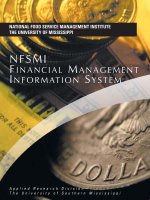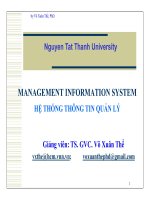Management information system ralp 7e ch04
Bạn đang xem bản rút gọn của tài liệu. Xem và tải ngay bản đầy đủ của tài liệu tại đây (1.34 MB, 50 trang )
• When selecting an operating system, you must consider the
current and future requirements for application software to
meet the needs of the organization. In addition, your choice
of a particular operating system must be consistent with
your choice of hardware.
• Identify and briefly describe the functions of the two basic
kinds of software
• Outline the role of the operating system and identify the
features of several popular operating systems
Principles of Information Systems, Seventh Edition
2
• Do not develop proprietary application software unless
doing so will meet a compelling business need that can
provide a competitive advantage
• Discuss how application software can support personal,
workgroup, and enterprise business objectives
• Identify three basic approaches to developing application
software and discuss the pros and cons of each
Principles of Information Systems, Seventh Edition
3
• Choose a programming language whose functional
characteristics are appropriate for the task at hand,
taking into consideration the skills and experience of
the programming staff
• Outline the overall evolution of programming
languages and clearly differentiate among the five
generations of programming languages
Principles of Information Systems, Seventh Edition
4
• The software industry continues to undergo constant
change; users need to be aware of recent trends and
issues to be effective in their business and personal
life
• Identify several key issues and trends that have an
impact on organizations and individuals
Principles of Information Systems, Seventh Edition
5
An Overview of Software
• Computer programs: sequences of instructions for the
computer
• Documentation: describes program functions to help
user operate computer system
• Systems software: set of programs that coordinates the
activities of hardware and programs
• Application software: programs that help users solve
particular problems
Principles of Information Systems, Seventh Edition
6
Table 4.1: Classifying Software by Type
and Sphere of Influence
Principles of Information Systems, Seventh Edition
7
Systems Software: Operating Systems
• Operating system (OS): a set of computer programs that
controls the computer hardware and acts as an interface
with application programs
• Kernel: ties all of the components of the OS together and
regulates other programs; controls the most critical
processes
Principles of Information Systems, Seventh Edition
8
Operating Systems (continued)
• Activities performed by the operating system:
• Perform common computer hardware functions
• Provide a user interface and input/output management
• Provide a degree of hardware independence
• Manage system memory
Principles of Information Systems, Seventh Edition
9
Operating Systems (continued)
• Activities performed by the operating system:
• Manage processing tasks
• Provide networking capability
• Control access to system resources
• Manage files
Principles of Information Systems, Seventh Edition
10
Figure 4.2:
Operating system as interface between
application software and hardware
Principles of Information Systems, Seventh Edition
11
Operating Systems (continued)
• Common hardware functions
• Get input from the keyboard or some other input device
• Retrieve data from disks
• Store data on disks
• Display information on a monitor or printer
Principles of Information Systems, Seventh Edition
12
Operating Systems (continued)
• User interface and input/output management
• User interface: allows individuals to access and command
the computer system
• Command-based user interface: requires that text
commands be given to the computer to perform basic
activities
• Graphical user interface (GUI): uses icons and menus
displayed on screen to send commands to computer system
Principles of Information Systems, Seventh Edition
13
Operating Systems (continued)
• Application program interface (API): allows
applications to make use of the operating system
• Memory management: control how memory is accessed
and maximize available memory and storage
Principles of Information Systems, Seventh Edition
14
Figure 4.3: Application Program Interface
Links Application Software to the
Operating System
Principles of Information Systems, Seventh Edition
15
Operating Systems (continued)
• Processing tasks
• Multitasking: capability allowing more than one program
to run at the same time
• Time-sharing: allows more than one person to use a
computer system at the same time
• Scalability: ability of the computer to handle an increasing
number of concurrent users smoothly
• Networking capability: features and capabilities of the OS
that aid users in connecting to a computer network
Principles of Information Systems, Seventh Edition
16
Operating Systems (continued)
• Access to system resources
• Protection against unauthorized access
• Logins and passwords
• File management: ensures that files in secondary storage
are available when needed and that they are protected
from access by unauthorized users
Principles of Information Systems, Seventh Edition
17
Table 4.3: Popular Operating Systems
Cross All Three Spheres of Influence
Principles of Information Systems, Seventh Edition
18
Current Operating Systems
• Microsoft PC operating systems
• Apple computer operating systems
• Linux
Principles of Information Systems, Seventh Edition
19
Workgroup Operating Systems
• Windows Server
• UNIX
• NetWare
• RedHat Linux
• Mac OS X Server
Principles of Information Systems, Seventh Edition
20
Enterprise Operating Systems
• z/OS
• MPE/iX and HP-UX
• Linux
Principles of Information Systems, Seventh Edition
21
Operating Systems for Small Computers
and Special-Purpose Devices
• Palm OS
• Windows Embedded
• Windows Mobile
Principles of Information Systems, Seventh Edition
22
Utility Programs
• Utility programs are used to:
• Merge and sort sets of data
• Keep track of computer jobs being run
• Compress data files before they are stored or transmitted
over a network
• Perform other important tasks
Principles of Information Systems, Seventh Edition
23
Utility Programs (continued)
• Hardware utilities
• Virus-detection and virus-recovery utilities
• File-compression utilities
• Spam and pop-up blocker utilities
Principles of Information Systems, Seventh Edition
24
Utility Programs (continued)
• Network and Internet utilities
• Server and mainframe utilities
• Other utilities
Principles of Information Systems, Seventh Edition
25









